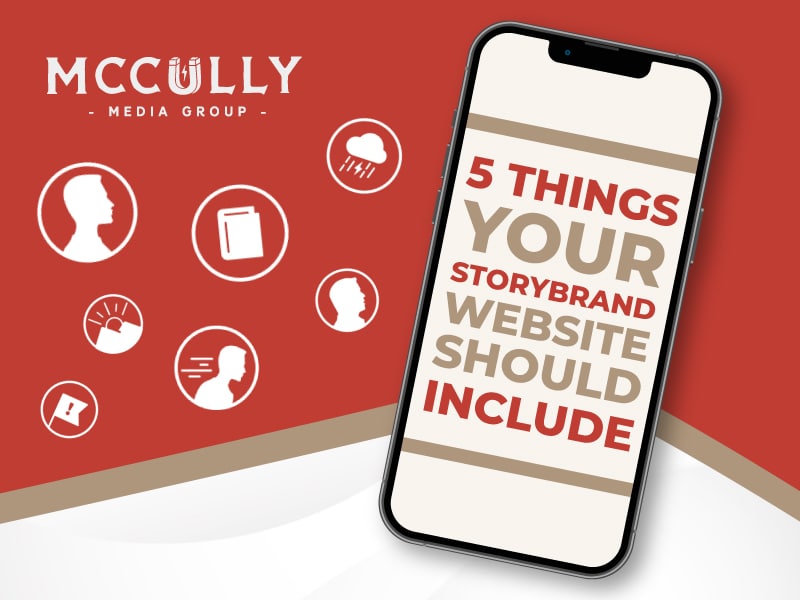Here at MMG, we often get asked, “How do I create a StoryBrand website for my business?” Donald Miller’s Storybrand Framework establishes a base for creating engaging stories that will capture your audience’s attention and help them understand your brand. The framework covers the hero’s journey, the brand promise, and the call to action.
The hero’s journey is the story of someone who overcomes obstacles to achieve their goal. The brand promise is what your company offers to help the hero achieve their goal. The call to action is what you want your audience to do after they’ve heard your story.
By following this framework, you can create a story that resonates with your audience and helps them understand your brand.
One of the best ways to put StoryBrand to work for your business is to create a StoryBrand-branded website. But what should your StoryBrand website include?
What Parts Should a StoryBrand BrandScript Website Include?

A lot goes into creating a StoryBrand BrandScript, but it doesn’t have to be daunting. Here’s a breakdown of how to get started:
- Know your audience. Who are you trying to reach with your website? What kind of information do they need? What will resonate with them? Knowing your audience is essential to crafting a BrandScript that will work for them.
- Simplify your message. Once you know who you’re talking to, it’s time to simplify your message. What’s the one thing you want them to remember after they visit your site? Keep it clear and concise, and make sure it’s relevant to their needs.
- Create a scene. A great BrandScript always starts with a scene that sets the stage and introduces the problem your character is facing. This helps to create empathy and gets readers invested in finding out how the story ends.
- Introduce the guide. Every great story has a character who knows more than the protagonist and can help them overcome their challenges.
- Get specific about the solution. Once you’ve established the problem and introduced the guide, it’s time to get specific about the solution. What exactly does your product or service do? How will it solve the reader’s problem? Be clear and direct, so there’s no confusion about what you’re offering.
- Reveal the plan. Now that you’ve explained what needs to happen, it’s time to show readers how it will all come together. Walk them through the steps they need to take to achieve their goal and make sure each step is clearly defined.
You’ve heard the expression “content is king.” Well, it’s true. But not just any content will do. If you want to succeed online, you need a website that tells your story in a clear and compelling way.
That’s where we come in. We’re experts at creating websites that help businesses connect with their customers and tell their stories in a way that engages and inspires people to take action.
We’ll work with you to create a website that reflects your unique brand and communicates your message in a way that speaks to your ideal customer. And we’ll make sure it looks great too!
Schedule a call today.
How to create a StoryBrand Website – 5 things your website should include:
1. An Aspirational Identity
We all have an idea of who we want to be — someone who is successful, healthy, and happy. While we may not always live up to our aspirations, they guide our actions and choices. Similarly, a brand’s aspirational identity represents who the customer wants to become by using the product or service. It’s a representation of their highest selves. And it’s this ideal that the customer strives to attain.
By aligning with an aspirational identity, brands can tap into their customers’ deepest desires and motivations. This allows them to create a connection that goes beyond the transactional, leading to loyalty and advocacy. When done right, an aspirational identity can be a powerful tool for any brand.
For example, Lululemon’s aspirational identity is “the sweaty set.” This represents their customer’s desire to be fit, healthy, and stylish. By aligning with this ideal, Lululemon has been able to create a strong connection with its customers.
2. A Direct Call to Action
A clear and direct call to action (CTA) is an essential part of any effective website. It tells your visitors what you want them to do, and it should focus on meeting your ideal customer’s needs.
Including a CTA on every page of your website ensures that your visitors will always know how to take the next step, whether it’s requesting a demo or making a purchase. And by making your CTA clear and concise, you can increase the likelihood of successfully achieving its goal. So, if you want to improve your website’s effectiveness, include a strong CTA.
Examples of clear CTAs are “Get a Free Demo” or “Buy Now.”
3. A Transitional Call to Action
In addition to a direct CTA, every page on your StoryBrand website should also have a transitional CTA. A transitional CTA moves your visitors from one stage of the buyer’s journey to the next.
For example, if someone is on your home page, their transitional CTA might be “Learn More.” But if they’re on your pricing page, their transitional CTA might be “Compare Plans.” Transitional CTAs are essential because they keep people moving through your website to eventually take the desired action (i.e., buy your product or service).
4. Very Simple Text
The text on your StoryBrand website should be straightforward — that is, easy to read and understand. That means using short sentences and common words rather than long paragraphs and jargon. Remember, you’re speaking to real human beings, not robots. So write as you would speak.
StoryBrand is about creating clarity for your customers so they can easily see the value in your offering. If your text is confusing or difficult to read, you’ll lose people’s attention — and potential sales. Keep it simple, clear, and human, and you’ll be on your way to success.
5. Customer-Focused Copy
You should always focus your website’s copy on the needs of your ideal customer. That means using language that resonates with them and addressing their pain points directly. For example, if you’re selling software that helps businesses automate their accounting, use language that speaks to the pain point of having to do manual accounting (e.g., “Say goodbye to tedious manual accounting”).
By focusing on the needs of your ideal customer, you’ll create copy that resonates with them and encourages them to take action. This will help you build a stronger relationship with your customers and ultimately grow your business.
These are just a few of the things that every StoryBrand website should include if you want it to be successful. Of course, there’s much more to building an effective website than can be covered in one blog post — but this is an excellent place to start. So if you’re looking to use StoryBrand in your marketing, make sure your website includes these five key elements.
Create Great StoryBrand Websites
You’ve heard the term “storytelling” thrown around a lot, but what does it really mean? And how can you use it to create a website that sells your products and services?
McCully Media Group can help. We’re experts in storytelling and website design, and we’ll work with you to create a website that’s not only beautiful but also effective in converting visitors into customers.
A well-designed website is essential for any business, large or small. Let us help you create a website that will make your business stand out from the competition and attract more customers than ever before.
Schedule a call today.
Learn More:
What Is A StoryBrand BrandScript?




